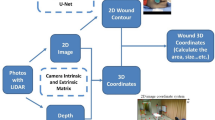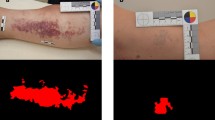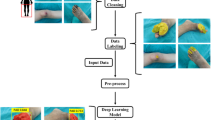Abstract
Pressure injury follow-up and treatment is a very costly and significant health care problem for many countries. Early and accurate diagnosis and treatment planning are critical for effective treatment of pressure injuries. Interventional information retrieval methods are both painful for patients and increase the risk of infection. However, thanks to non-invasive techniques such as imaging systems, it is possible to monitor pressure wounds more easily without causing any harm to patients. The purpose of this research is to develop a deep learning-based system for the analysis and monitoring of pressure injuries that provides an automatic classification of pressure injury stages. This paper introduces the pressure injury images dataset (PIID): a novel dataset for the classification of pressure injuries stages. We hope that PIID will encourage further research on the automatic visual classification of pressure injury stages. We also perform extensive analyses on PIID using state-the-of-art convolutional neural networks architectures with the power of transfer learning and image augmentation techniques.





Similar content being viewed by others
References
Klonoff DC (2009) The increasing incidence of diabetes in the 21st century. J Diabetes Sci Technol 3(1):1–2. https://doi.org/10.1177/193229680900300101
Pieper B (2015) Pressure ulcers: impact, etiology, and classification. In: Acute and chronic wounds: current management concepts, pp 124–139
Horn SD, Bender SA, Ferguson ML et al (2004) The national pressure ulcer long-term care study: pressure ulcer development in long-term care residents. J Am Geriatr Soc 52:359–367
Berlowitz D, Vandeusen Lukas C, Parker V et al (2018) Preventing pressure ulcers in Hospitals. Agency for Healthcare Research and Quality, Rockville, MD. https://www.ahrq.gov/patientsafety/settings/hospital/resource/pressureulcer/tool/index.html
Brown G (2003) Long-term outcomes of full-thickness pressure ulcers: healing and mortality. Ostomy Wound Manage 49:42–50
Soldevilla Agreda JJ et al (2007) The burden of pressure ulcers in Spain. Wounds Compend Clin Res Pract 19(7):201–206
Tubaishat A, Papanikolaou P, Anthony D, Habiballah L (2018) Pressure ulcers prevalence in the acute care setting: a systematic review, 2000–2015. Clin Nurs Res 27:643–659. https://doi.org/10.1177/1054773817705541
Zahia S, Garcia Zapirain MB, Sevillano X et al (2020) Pressure injury image analysis with machine learning techniques: a systematic review on previous and possible future methods. Artif Intell Med 102:101742. https://doi.org/10.1016/j.artmed.2019.101742
Edsberg LE, Black JM, Goldberg M et al (2016) Revised national pressure ulcer advisory panel pressure injury staging system: revised pressure injury staging system. J Wound Ostomy Cont Nurs 43:585
Jiang Q, Li X, Qu X et al (2014) The incidence, risk factors and characteristics of pressure ulcers in hospitalized patients in China. Int J Clin Exp Pathol 7:2587
Kasikci M, Aksoy M, Ay E (2018) Investigation of the prevalence of pressure ulcers and patient-related risk factors in hospitals in the province of Erzurum: a cross-sectional study. J Tissue Viabil 27:135–140. https://doi.org/10.1016/j.jtv.2018.05.001
David OP, Sierra-Sosa D, Zapirain BG (2017) Pressure ulcer image segmentation technique through synthetic frequencies generation and contrast variation using toroidal geometry. Biomed Eng Online 16:1–19. https://doi.org/10.1186/s12938-016-0298-3
Leachtenauer J, Kell S, Turner B et al (2006) A non-contact imaging-based approach to detecting stage pressure ulcers. Annu Int Conf IEEE Eng Med Biol Proc. https://doi.org/10.1109/IEMBS.2006.259513
Guadagnin R, De Neves RS, Santana LA, Guilhem DB (2014) An image mining based approach to detect pressure ulcer stage. Pattern Recognit Image Anal 24:292–296. https://doi.org/10.1134/S1054661814020084
Hansen GL, Sparrow EM, Kokate JY et al (1997) Wound status evaluation using color image processing. IEEE Trans Med Imaging 16:78–86. https://doi.org/10.1109/42.552057
Mankar NB (2013) Comparision of different ımaging techniques used for chronic wounds. Int J Res Eng Technol 02:68–70. https://doi.org/10.15623/ijret.2013.0207009
Kermany DS, Goldbaum M, Cai W et al (2018) Identifying medical diagnoses and treatable diseases by image-based deep learning. Cell 172:1122–1131
Zahia S, Sierra-Sosa D, Garcia-Zapirain B, Elmaghraby A (2018) Tissue classification and segmentation of pressure injuries using convolutional neural networks. Comput Methods Programs Biomed 159:51–58
Garcia-Zapirain B, Shalaby A, El-Baz A, Elmaghraby A (2017) Automated framework for accurate segmentation of pressure ulcer images. Comput Biol Med 90:137–145
Silva RHL, Machado AMC (2021) Automatic measurement of pressure ulcers using support vector machines and grabcut. Comput Methods Progr Biomed. https://doi.org/10.1016/j.cmpb.2020.105867
Elmogy M, Garcia-Zapirain B, Burns C et al (2018) Tissues classification for pressure ulcer images based on 3D convolutional neural network. Proc Int Conf Image Process ICIP. https://doi.org/10.1109/ICIP.2018.8451119
Zahia S, Garcia-Zapirain B, Elmaghraby A (2020) Integrating 3D model representation for an accurate non-invasive assessment of pressure injuries with deep learning. Sensors (Switzerland) 20:1–15. https://doi.org/10.3390/s20102933
Chakraborty C (2019) Computational approach for chronic wound tissue characterization. Inform Med Unlocked 17:100162
Yilmaz B, Atagun E, Demircan FO, Yucedag I (2021) Classification of pressure ulcer images with logistic regression. Int Conf Innov Intell Syst Appl INISTA 2021 Proc. https://doi.org/10.1109/INISTA52262.2021.9548585
Kosmopoulos DI, Tzevelekou FL (2007) Automated pressure ulcer lesion diagnosis for telemedicine systems. IEEE Eng Med Biol Mag 26:18–22
Marijanović D, Filko D (2020) A systematic overview of recent methods for non-contact chronic wound analysis. Appl Sci 10:1–28. https://doi.org/10.3390/app10217613
Bedo MVN, Santos LFD, Oliveira WD et al (2015) Color and texture influence on computer-aided diagnosis of dermatological ulcers. Proc IEEE Symp Comput Med Syst. https://doi.org/10.1109/CBMS.2015.33
Mukherjee R, Manohar DD, Das DK et al (2014) Automated tissue classification framework for reproducible chronic wound assessment. Biomed Res Int. https://doi.org/10.1155/2014/851582
Chakraborty C, Gupta B, Ghosh SK et al (2016) Telemedicine supported chronic wound tissue prediction using classification approaches. J Med Syst 40:68
Veredas F, Mesa H, Morente L (2009) Binary tissue classification on wound images with neural networks and bayesian classifiers. IEEE Trans Med Imaging 29:410–427
Chakraborty C, Gupta B, Ghosh SK (2015) Chronic wound tissue characterization under telemedicine framework. In: 2015 17th ınternational conference on E-health networking, application & services (HealthCom). pp 569–573
Wannous H, Lucas Y, Treuillet S (2010) Enhanced assessment of the wound-healing process by accurate multiview tissue classification. IEEE Trans Med Imaging 30:315–326
Veredas FJ, Luque-Baena RM, Martin-Santos FJ et al (2015) Wound image evaluation with machine learning. Neurocomputing 164:112–122
Wannous H, Treuillet S, Lucas Y (2010) Robust tissue classification for reproducible wound assessment in telemedicine environments. J Electron Imaging 19:23002
Mesa H, Veredas FJ, Morente L (2008) A hybrid approach for tissue recognition on wound images. In: 2008 eighth ınternational conference on hybrid ıntelligent systems. pp 120–125
García-Zapirain B, Elmogy M, El-Baz A, Elmaghraby AS (2018) Classification of pressure ulcer tissues with 3D convolutional neural network. Med Biol Eng Comput 56:2245–2258. https://doi.org/10.1007/s11517-018-1835-y
Ahmad Fauzi MF, Khansa I, Catignani K et al (2015) Computerized segmentation and measurement of chronic wound images. Comput Biol Med 60:74–85. https://doi.org/10.1016/j.compbiomed.2015.02.015
Shenoy VN, Foster E, Aalami L et al (2019) Deepwound: automated postoperative wound assessment and surgical site surveillance through convolutional neural networks. Proc 2018 IEEE Int Conf Bioinform Biomed BIBM 2018. https://doi.org/10.1109/BIBM.2018.8621130
Nejati H, Ghazijahani HA, Abdollahzadeh M et al (2018) Fine-grained wound tissue analysis using deep neural network. ICASSP IEEE Int Conf Acoust Speech Signal Process Proc. https://doi.org/10.1109/ICASSP.2018.8461927
V. Godeiro, J. S. Neto, B. Carvalho, B. Santana, J. Ferraz and R. Gama, (2018) Chronic wound tıssue classıfıcatıon usıng convolutıonal networks and color space reduction. IEEE 28th ınternational workshop on machine learning for signal processing (MLSP), pp 1–6, https://doi.org/10.1109/MLSP.2018.8517026.
Pholberdee N, Pathompatai C, Taeprasartsit P (2018) Study of chronic wound ımage segmentation: ımpact of tissue type and color data augmentation. In: Proceeding 2018 15th Int Jt Conf Comput Sci Softw Eng JCSSE 2018, pp 1–6, https://doi.org/10.1109/JCSSE.2018.8457392
Haesler E (2019) European Pressure ulcer advisory panel, national pressure ınjury advisory panel, and pan pacific ınjury alliance. In: Prev Treat Press ulcers/injuries Clin Pract Guidel Int Guidel EPUAP/NPIAP/PPPIA
Ren S, He K, Girshick R, Sun J (2016) Faster R-cnn: towards real-time object detection with region proposal networks. IEEE Trans Pattern Anal Mach Intell 39:1137–1149
Barone AVM, Haddow B, Germann U, Sennrich R (2017) Regularization techniques for fine-tuning in neural machine translation. arXiv Prepr arXiv:1707.09920
Funding
The study was reviewed and approved by the ethics committee of Firat University, Turkey. The work reported on in this paper was substantially performed using computing resources from Big Data and Artificial Intelligence Laboratory (BVYZLab) at Firat University.
Author information
Authors and Affiliations
Corresponding author
Ethics declarations
Conflict of interest
All authors declare that they have no conflict of interest.
Additional information
Publisher's Note
Springer Nature remains neutral with regard to jurisdictional claims in published maps and institutional affiliations.
Rights and permissions
About this article
Cite this article
Ay, B., Tasar, B., Utlu, Z. et al. Deep transfer learning-based visual classification of pressure injuries stages. Neural Comput & Applic 34, 16157–16168 (2022). https://doi.org/10.1007/s00521-022-07274-6
Received:
Accepted:
Published:
Issue Date:
DOI: https://doi.org/10.1007/s00521-022-07274-6




